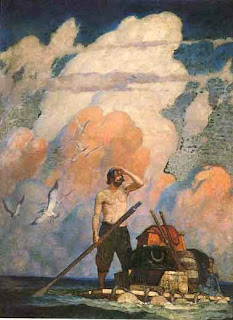 In last week’s experiment with Gender Genie 4 out of 6 Jane Austen heroes tested out as girls based on their dialogue. Thinking this might reflect the gender of the author, I decided to try some heroes from period novels by men. I ran Sir Walter Scott’s Waverley and Guy Mannering and found they squeaked out as males, though not by a lot. Going back a bit earlier, I checked out Robinson Crusoe. According to Gender Genie, this macho survivor is overwhelmingly a girl. (Wonder what this means for his Man Friday?)
In last week’s experiment with Gender Genie 4 out of 6 Jane Austen heroes tested out as girls based on their dialogue. Thinking this might reflect the gender of the author, I decided to try some heroes from period novels by men. I ran Sir Walter Scott’s Waverley and Guy Mannering and found they squeaked out as males, though not by a lot. Going back a bit earlier, I checked out Robinson Crusoe. According to Gender Genie, this macho survivor is overwhelmingly a girl. (Wonder what this means for his Man Friday?)
I boldly took the next step: putting some of my own heroes’ dialogue through the thing. Ack! My last two heroes, Verwood of SAVING LORD VERWOOD and Jeremy from LADY DEARING’S MASQUERADE both tested about as girly as Mr. Knightley and Captain Wentworth. Though I put it down to period dialogue, it still scared me. Though both these books did well, perhaps readers prefer heroes in modern historical romance to speak a bit more like modern men (none of the words used by Gender Genie to differentiate between male and female are anachronistic to the Regency).
So I ran dialogue for several popular (and RITA winning) historical romance heroes through the tool. And to my great relief, Rothgar from Jo Beverley’s Malloren series and Reggie Davenport from Mary Jo Putney’s THE RAKE AND THE REFORMER both tested out in a similar range.
I feel vindicated. Readers are smart enough to recognize a character’s masculinity despite period dialogue. Whew! 🙂
Just for giggles (and you thought we were done–ha!) I decided to run a contemporary romance hero through the tool. I chose Ken from Suzanne Brockmann’s OUT OF CONTROL. I figured a modern Navy SEAL ought to test out male. He did, with the most masculine score of all the heroes I ran through the tool. So maybe Gender Genie has some validity for those writing contemps.
Anyway, I’m done worrying about Gender Genie. I will just have to find something else to obsess about now. 🙂
Is there anything you get OC about? Re works-in-progress or anything else? Do you dive into these things or wisely avoid the temptation?
Elena
www.elenagreene.com


